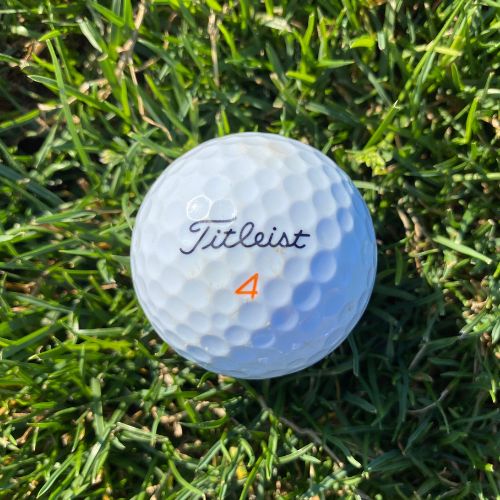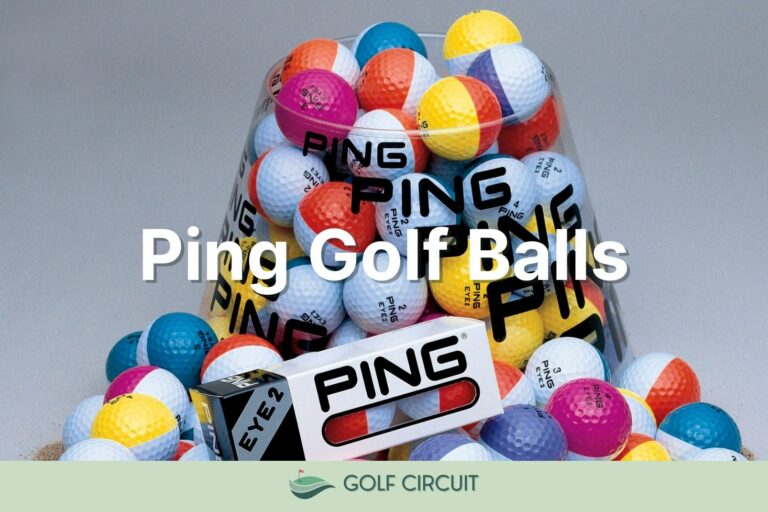Titleist Velocity Golf Balls Review: Great In 2023

This is our in-depth Titleist Velocity Golf Balls Review.
To the novice, it might seem like all golf balls are pretty much the same. But experienced golfers know that different golf balls have unique design features that affect the speed and aerodynamics of how the ball flies.
Subtle changes in the core, the design of the dimples, and the compression of a golf ball can significantly affect the feel and the flight of a ball.
And since every golfer plays in their unique way, it is vital to find a golf ball that fits your game style. Titleist even has a golf ball selection tool on their website to help people find the perfect ball.
If you are wondering whether the Titleist Velocity golf balls are a good fit for you, stick around to read our complete review.
In addition to giving you a Titleist Velocity golf balls review, we’ll also explore how this ball stacks up against other popular Titleist balls like the Pro V1.
Overview of Titleist Velocity Golf Ball
Every golf ball has design features that optimize it for a specific aspect of the game. Some players care most about their short game and the ability to spin and control the ball.

Other players care most about the long-range trajectory and the feel of the golf ball. Part of the fitting process is finding a ball that matches up with your priorities.
And the Titleist Velocity golf ball, which first came out in 2018, is a ball that emphasizes speed and distance.
As the name suggests, this Velocity ball launches off the tee with high speed and low spin, both of which encourage the ball to travel further.
A great deal of Titleist Velocity golf ball reviews reaffirms these claims, with countless golfers saying they can’t believe switching balls alone gave them 15-20 yards on their drive.
Almost every design aspect of the Velocity ball—the core, the cover, the compression, and the tile design—all come together to optimize for high flight and downrange distance while also maintaining playability on the green. The main features include:
- Long downrange distance
- Low long game spin
- High flight ball
- Comfortable feel on the green
- Available in white, matte green, matte orange, and matte pink
Now that you have an overview of what the Titleist Velocity golf ball offers, let’s get into more details of how its design achieves high flight, low spin, and long downrange distance.
Design Fundamentals
How a golf ball feels and flies essentially comes down to its design’s physics and engineering principles.
And this golf ball manages to balance a high flight and long-distance with an easy ability to stop on the green.
How do Titleist Velocity golf balls manage to perform like this? The answer comes down to its design principles which optimize for speed and distance. It features:
- A larger sized core
- High-speed LSX core material
- NaZ+ ball cover that hardens the ball
- 350 octahedral dimple design for high-flying trajectory
The LSX core manages to get a higher speed both because of its material and its size. This larger core is the main factor behind the Velocity’s impressive speed and distance.

Not only does it launch off of the tee with a fast initial speed, but it also has a low spin that provides a long and consistent flight.
This golf ball’s larger core also helps you with your approach shots. With these shorter-range swings, the large core increases the spin that will help the ball stop where it lands.
A larger core also means that the ball will generally be more likely to stop where you want it to.
You can’t optimize a single golf ball for everything, but the fact that you can drive such an impressive distance while also having enough weight to stop is impressive.
The engineers at Titleist also put a lot of thought into how the ball’s cover could help it find a long and consistent flight.
The Titleist Velocity has a Surlyn ionomer cover that hardens the ball to help maximize speed. This cover also contributes to that low spin we talked about on the drive. As you can see, the design features of this ball work together in harmony.
The last unique design feature worth expanding on is the design of the dimples. Velocity has a spherical tile design and a 350 octahedral dimple pattern that supports and encourages the aerodynamics of long-distance flight.
Along with the core and the cover, the dimples contribute to the ball’s ability to have an impressively high-flying trajectory.
Who It Is Made for
When it comes to choosing a specific golf ball, it’s hard to say for sure who might enjoy the particular golf ball. It all depends on the individual’s preference for the feel of the ball and what part of the game they want to optimize.
In the case of Velocity, it caters to people who want to drive at a higher speed than ever and watch their drives go farther than ever.
Velocity’s design ensures that speed and distance are a priority.
But prioritizing distance and speed can come at a cost. While the newest version of the Titleist Velocity corrects for some of the short game deficits, it is still the case that Velocity is not a ball intended for someone who wants to maximize performance on the green.

This downside is not to say that this golf ball will be a problem on the green, but rather that gaining so much advantage in distance and speed naturally takes away from the precision of your short game.
So the Titleist Velocity is primarily for those golfers who want to experiment with a ball that will give them more power and distance on their drives.
Especially if you have been struggling with distance, this ball will be able to help you get back to your old driving range.
But if you are confident in your swing speed on the drive and want more nuanced control over the shorter aspects of your golf game, this Velocity ball might not be ideal for you.
Color Options
Besides the technical details of the ball’s design and how it works, there’s also the factor of adding personality and style to your golf game.
Plain white balls are fine, but unique colors can bring a bit more excitement to your golf game, especially with a great ball like the Velocity. It comes in white, matte green, matte orange, and matte pink.
Yes, it is true that golf balls with a unique and bright color visually stand out on the course and are easier to find—that is probably the main reason people choose unique colors.

But it is equally true that one of Velocity’s stylish colors like bright green or pink will also bring some personality to your game. If you are going to choose a top-performing ball, why not look stylish while doing it?
Weirdly enough, at least a few reviews claimed that the Titleist orange golf balls, in particular, gave them much more distance on their game.
Velocity balls generally seem to improve people’s driving range, but for some reason, orange appeared to be the preferred color for maximizing distance.
There is no engineering principle behind such a claim, but then again, who knows how people react to specific colors.
We’ll leave it up to you to decide if that’s just a psychological factor or if it has the chance of being true. But either way, if you want to increase your driving distance and do so in style, it can’t hurt to give the orange balls a try.
What Is the Compression of the Titleist Velocity Golf Ball
Even though a golf ball feels completely solid to the touch, slow-motion cameras show that the ball compresses slightly upon contact with your club.
This compression is part of the energy equation that propels the ball forward, and it is also something that you, like the golfer, can feel. Balls can be softer or harder and hence have more or less compression.
Lower compression golf balls, those with a roughly 80 and lower rating, tend to travel farther with less effort. They compress more on impact with the club and hence spring forward with more energy.
And higher compression balls, with a rating of 100 or higher, are harder to get distance on but easier to control. These are best for golfers with a particularly fast swing.
The Titleist Velocity compression is in the middle of the range because it feels soft but is not as soft as something like the Titleist TruFeel. But compared to higher compression ratings of balls like the Titleist Pro V1, you can expect a much softer feel to Velocity.
This lower compression combined with the larger core is the primary cause of Velocity’s impressive distance ability.
Titleist Velocity Golf Ball Vs. Pro V1 Golf Ball

If you are still unsure whether the Titleist Velocity is the right ball for you, maybe comparing it to another professional level ball by Titleist will be helpful. So let’s explore some of the similarities and differences between Velocity and Pro V1 golf balls.
The Pro V1 is a bit more expensive than the Velocity balls, and many professional golfers choose to compete with this ball.
Compared with the lower compression of Velocity, Pro V1 is quite a firm golf ball with a compression rating of over 100.
This firmness means that distance is not prioritized as much with Pro V1, unlike the Velocity balls.
This higher compression might be a problem for more amateur players because they will struggle to get enough distance with this ball.
But professional players can swing up to 130 mph, which helps to counteract the high compression and still give them range. Plus, a more firm ball like the Pro V1 also means that you get a nice spin on the greens.
So it makes sense that the Pro V1 is a preferred ball for professional golfers who care much more about the subtlety of control and need less help getting speed and power on their drive. The distinct features of the Pro V1 include:
- Great short game control
- A soft Cast Urethane elastomer cover system
- 2.0 ZG process core
- Spherical tile design with 388 tetrahedral dimples
The softer elastomer cover, in particular, is what gives the Pro V1 such an impressive short game ability.
You can get a great spin on the green and control your shorter strokes. But on the other hand, this ball is designed with the professional in mind. You need to have solid swing speed and technique to get adequate distance with this ball.
So while it is hard to give a one-size-fits-all recommendation when comparing these two balls, you will want to take an honest assessment of your game before deciding.
If having spin control and short game flexibility is most important to you, the Pro V1 will win every time.
But if you are struggling to get the distance you want and are not skilled enough to need precise control on the green yet, the Velocity balls will deliver you an impressive range.
Final Thoughts
When it comes to giving an accurate Titleist Velocity golf balls review, we believe you mostly have to get the feel of these golf balls for yourself.
The combination of club, swing, and ball specifications all factor into your performance. Some people prefer a firm ball and a fast swing, and others prefer to get their driving distance with a low-compression ball and a slower swing.
So assuming that you have taken your personal preferences into account, the Titleist Velocity golf ball is overall a high-quality golf ball, as you would expect from Titleist.
And it does perform the way they claim it will. And while the newest version addresses some of the short game deficits, its long game performance still takes away from the control you might want on the green.
Check them out here.
But if you want to maximize your driving distance and tee-off speed, this ball is worth the investment.






Can you please answer? 85 mph driver speed. How far will each Titleist go if hit dead square. Please give a definite answer.
Hey Tony! You can expect to drive the ball about 220-250 yards with the Titleist Velocity and an 85 mph swing speed. The Pro V1X will give you similar results, probably close to the higher end of that spectrum.